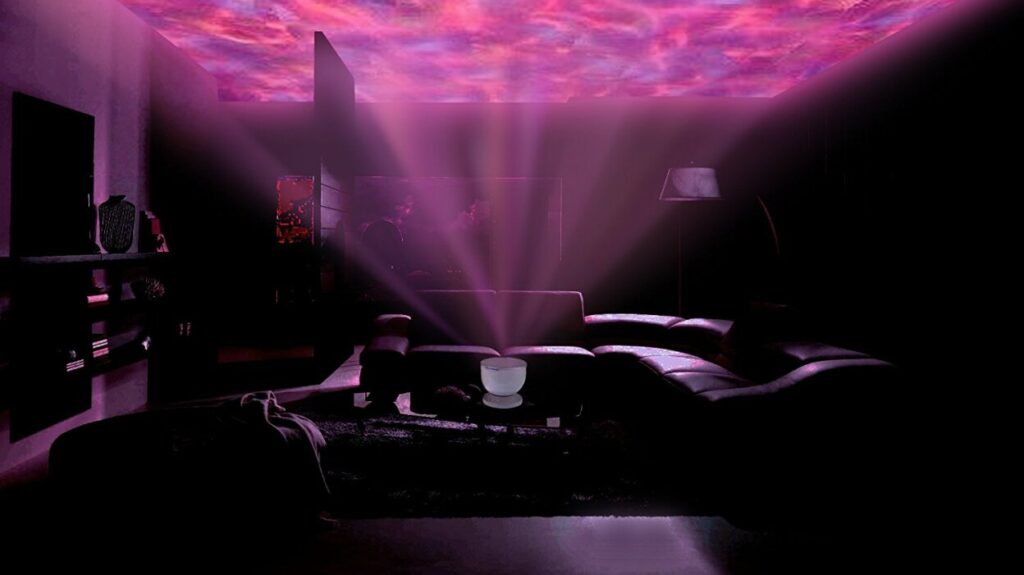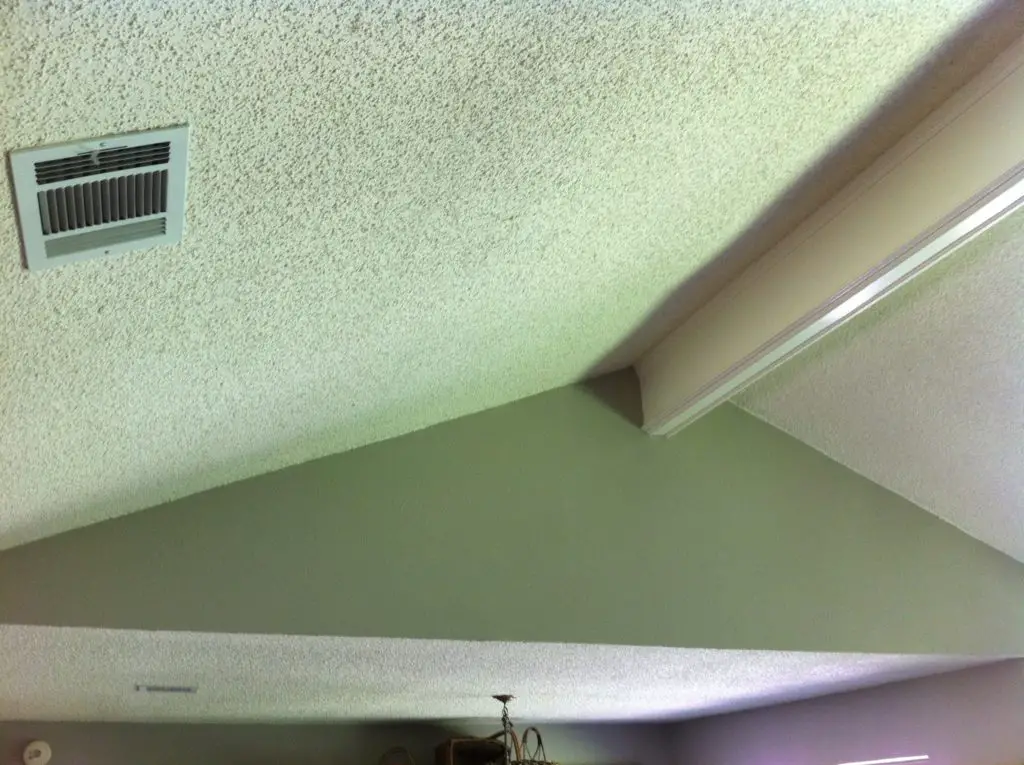Projectors are generally used in flat, white surfaces for the best possible viewing experience. But having a projection on the ceiling and watching while lying on the bed can be an experience.
So, are you wondering if projector on popcorn ceiling works?
Projectors can be used on popcorn ceilings. But it can lead to image distortion, reduced brightness, and unevenness due to the texture. Harsh shadows may be created, requiring soft lighting. Positioning the projector correctly, having the right color, adjusting focus and zoom. And even using a projector screen can help mitigate these issues and improve the viewing experience.
This is just the gist of it. Find out everything else you need to know right here!
Can You use a projector on a popcorn ceiling?
So can I use a projector on a popcorn ceiling? You sure can, but it is not the best choice.
Popcorn ceilings, also known as textured ceilings, have a rough and bumpy surface. While they may not be an ideal projection surface, projectors can still be used on them.
But the texture of the ceiling can cause distortion and unevenness in the projected image. This may result in a slightly grainy or less sharp picture.
The bumps and irregularities on the surface can also scatter and diffuse the light. It may lead to reduced brightness and overall image quality.
To optimize the projection experience on a popcorn ceiling, you should take a few steps. First, ensure that the projector is positioned perpendicular to the viewing area. This is to minimize distortion caused by the uneven surface. Adjusting the projector’s angle and distance can help achieve the best results.
This also means that a projector with a ceiling fan won’t work.

It’s also crucial to choose a projector with sufficient brightness. Because the popcorn texture can reduce the perceived brightness of the image.
How To Use Projector On Popcorn Ceiling?
Here is how to correctly use a projector on textured wall. Follow the below steps.
- Correctly position the projector. The size of the room and the preferred viewing distance will affect where a projector should be placed.
But generally speaking, you should hang the projector on the ceiling or wall as high as you can. This will lessen the image’s exposure to the texture of popcorn.
- Zoom and focus need to be adjusted. To get the best image possible after installing the projector, you’ll need to adjust the focus and zoom. Sharpen the image with the focus knob, and you can enlarge or reduce the image using the zoom knob.
- Make use of a projector screen. A projector screen gives the projector a smooth, flat surface to project onto. This helps to enhance the image quality. You may use a white wall or a sheet of white poster board in place of a projector screen.
- Regularly clean the projector’s lens. The image may appear hazy or distorted if there is dust or other debris on the projector lens. Make use of a gentle, dry towel to clean the lens.

Do Projectors Work On Textured Walls?
Projectors work on textured walls, however the texture can affect the image. Textured walls can distort and grain the projected image. Texture inconsistencies scatter and diffuse light, diminishing image brightness and clarity.
Consider these issues when projecting on textured walls. To prevent distortion from wall bumps and grooves, position the projector accurately. Adjusting the viewing angle and positioning the projector perpendicular to the viewing area can assist.
Increase the projector’s brightness or choose a model with more lumens. This is to compensate for light diffusion and maintain a vibrant image. So having a brighter projector, like the 5050UB over LS12000, will be a better idea.
The textured wall’s hue can also affect image quality. Light-colored walls improve projection brightness and contrast. Color accuracy and image quality may be affected by wall paint.
So projectors can be used on textured walls. However image quality may be lower than on flat surfaces or specialized projection screens. If possible, employing a projection screen or alternate surface would improve outcomes and viewing quality.
Does the Color Of the Wall Matter For a Projector?
Yes, the color of the wall can indeed have an impact on the projected image when using a projector. A white wall is commonly used as a projection surface. Grey is often considered the best color for a projector wall. It is due to its balance between reflectivity and light absorption.
It provides a neutral backdrop that enhances contrast and improves image quality. Grey walls help to reduce ambient light reflection, resulting in deeper blacks and better color reproduction.
In addition to grey, there are a few other colors that can be used effectively for a projector wall. Light yellow, light pink, light blue, and light green walls can work well. It is because they have relatively high reflectivity, helping to maintain a bright image. These colors also tend to provide a pleasant and immersive viewing experience.
On the other hand, black walls may be used to create a more immersive and theater-like environment. However, it’s important to note that black walls absorb more light. So the overall brightness of the projected image may be reduced. This can lead to a decrease in image vibrancy and potential loss of detail, particularly in darker scenes.
What Lighting Is Best For Popcorn Ceiling?
When it comes to lighting for popcorn ceilings, there are a few things to keep in mind.You’ll want to choose lighting that will help to diffuse the light and create a soft, even glow. Also you’ll want to choose lighting that is bright enough to light up the room without being too harsh.
- Soft or frosted light bulbs: These help diffuse and soften any harsh shadows and create a more comfortable atmosphere.
- Table and floor lamps: Good, soft lighting via table and floor lamps will reduce harsh shadows. And turn your popcorn ceiling into a soft, subtle textural element.
- Pot lights or recessed lights: These are sleek and stylish, but above all, they are flush with the ceiling. It helps to create a smooth, uninterrupted look.
Disadvantages of Using a Projector on a Popcorn Ceiling
Let’s look at what you lose by using a projector on a popcorn ceiling.
- Image quality: The texture of the popcorn ceiling could cause the image to appear distorted or uneven. Especially towards the edges of the image.
- Reflectivity: Popcorn ceilings may not reflect light as well as a flat surface. This could result in a less clear or bright image.
- Shadows: Lighting: Popcorn ceilings can reflect light in a way that creates harsh shadows. This makes it important to use good, soft lighting via table and floor lamps to reduce these shadows.
- Throw distance: The throw distance from the floor to the ceiling will often be considerable. So you’ll likely need to find somewhere high up for the projector. That is if you want anything smaller than a 55-inch picture.
Frequently Asked Questions (FAQs):
Is popcorn ceiling waterproof?
No, popcorn ceiling is not waterproof. It is a textured finish typically made from a mixture of paint and Styrofoam. This can absorb moisture and get damaged if exposed to water.
How many watts does a ceiling projector use?
An average projector uses 200-300 watts. But the wattage of a ceiling projector can vary depending on the make and model. The higher the lumens output of a projector, the higher the power usage.
What is the disadvantage of popcorn ceiling?
Popcorn ceilings can be difficult to clean, collect dust and allergens. They have limited design options, may contain asbestos (for older installations), and can be challenging to repair or remove.
Conclusion
And with that you know whether you can use a projector on popcorn ceiling or not. You can but it may not be the best experience. But follow our instructions to make sure you make the best of it. Good luck!
